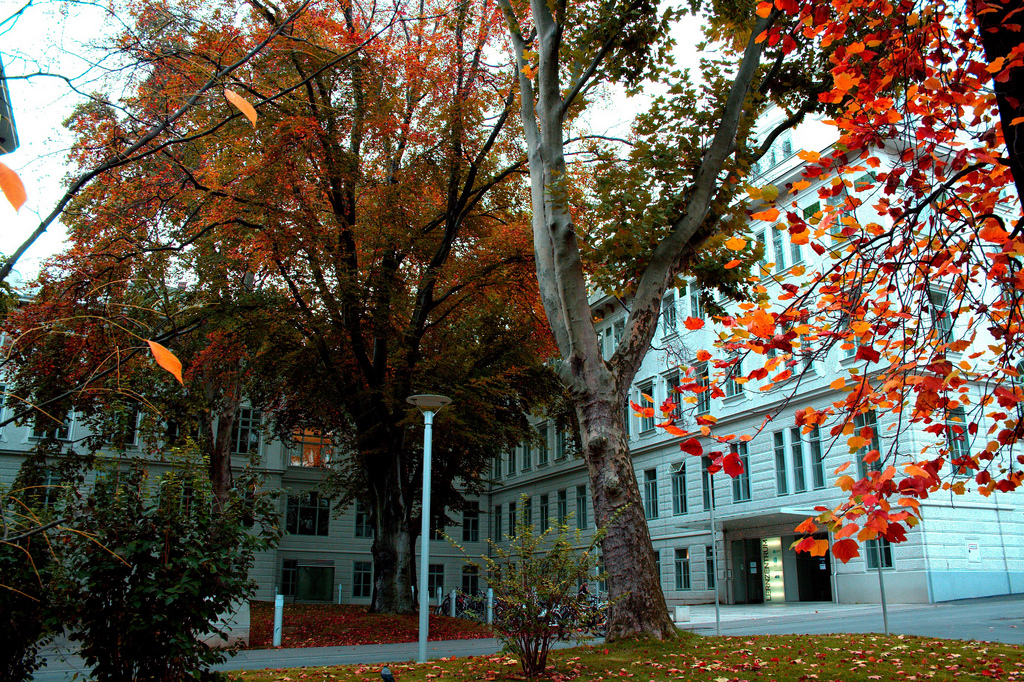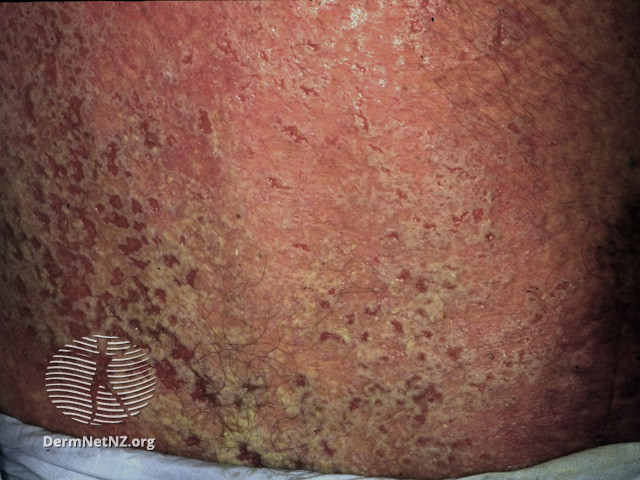|
Auspitz's Sign
Auspitz's sign is the appearance of punctate bleeding spots when psoriasis scales are scraped off, named after Heinrich Auspitz. Importantly, as with many eponymous clinical signs, Heinrich Auspitz was not the first to discover the sign named after him. It was Auspitz's mentor at the Medical University of Vienna ( Ferdinand von Hebra) and Parisian dermatologist Marie Devergie who first noted the punctate hemorrhages underlying psoriasis scales. This pinpoint bleeding results from a thinning of the epidermal layer overlying the tips of the dermal papillae. Blood vessels within the papillae are dilated and tortuous, and often bleed readily when the scale is removed. Although classically associated with psoriasis, subsequent research has found Auspitz's sign to be of very little diagnostic value for the disease. This is because several other diseases display the sign (including Darier's disease and actinic keratosis Actinic keratosis (AK), sometimes called solar keratosis or seni ... [...More Info...] [...Related Items...] OR: [Wikipedia] [Google] [Baidu] |
Psoriasis
Psoriasis is a long-lasting, noncontagious autoimmune disease characterized by raised areas of abnormal skin. These areas are red, pink, or purple, dry, itchy, and scaly. Psoriasis varies in severity from small, localized patches to complete body coverage. Injury to the skin can trigger psoriatic skin changes at that spot, which is known as the Koebner phenomenon. The five main types of psoriasis are plaque, guttate, inverse, pustular, and erythrodermic. Plaque psoriasis, also known as psoriasis vulgaris, makes up about 90% of cases. It typically presents as red patches with white scales on top. Areas of the body most commonly affected are the back of the forearms, shins, navel area, and scalp. Guttate psoriasis has drop-shaped lesions. Pustular psoriasis presents as small, noninfectious, pus-filled blisters. Inverse psoriasis forms red patches in skin folds. Erythrodermic psoriasis occurs when the rash becomes very widespread, and can develop from any of the other types. ... [...More Info...] [...Related Items...] OR: [Wikipedia] [Google] [Baidu] |
Heinrich Auspitz
Carl Heinrich Auspitz (2 September 1835 in Nikolsburg, Moravia – 22 May 1886 in Vienna) was a Jewish Austrian dermatologist. He was the husband of pianist Auguste Auspitz-Kólar (1843–1878).Statement(s) based on translated text from an equivalent article at the German Wikipedia. He was a member of the famous Moravian-Austrian . Heinrich was a son of Jewish surgeon (1803, Nikolsburg 1880). His younger brother (1838, Nikolsburg 1907) was an Imperial & Royal ''Generalmajor'' and writer. In 1840, Moritz was given a job at a Jewish hospital in Vienna, and allowed better education to his sons. Trained at the University of Vienna, he specialized in dermatology and syphilis. He was part of the so-called Vienna School of Dermatology, and studied and worked with several eminent physicians of the time; Ernst Wilhelm (Ritter von) Brücke (1819, Berlin 1892), Karel ''(Carl)'' Freiherr von Rokytanský (1804, Bohemia 1878), Josef Škoda (1805, Bohemia 1881), Johann Ritter von Oppolze ... [...More Info...] [...Related Items...] OR: [Wikipedia] [Google] [Baidu] |
Medical University Of Vienna
The Medical University of Vienna (German: ''Medizinische Universität Wien'') is a public university located in Vienna, Austria. It is the direct successor to the faculty of medicine at the University of Vienna, founded in 1365 by Rudolf IV, Duke of Austria. As one of the oldest medical schools in the world, it is the oldest in the German-speaking countries, and was the second medical faculty in the Holy Roman Empire, after the Charles University of Prague. The Medical University of Vienna is the largest medical organisation in Austria, as well as one of the top-level research institutions in Europe and provides Europe's largest hospital, the Vienna General Hospital, with all of its medical staff. It consists of 31 university clinics and clinical institutes, and 12 medical-theoretical departments, which perform around 48,000 operations each year. The Vienna General Hospital has about 100,000 patients treated as inpatients and 605,000 treated as outpatients each year. There hav ... [...More Info...] [...Related Items...] OR: [Wikipedia] [Google] [Baidu] |
Ferdinand Ritter Von Hebra
Ferdinand Karl Franz Schwarzmann, Ritter von Hebra (7 September 1816, in Brno, Moravia – 5 August 1880 in Vienna, Austria-Hungary) was an Austrian physician and dermatologist known as the founder of the New Vienna School of Dermatology, an important group of physicians who established the foundations of modern dermatology. Life Ferdinand Schwarzmann von Hebra was born to a military officer. He first studied in Graz, then entered the University of Vienna and graduated in medicine in 1841. He was influenced by Carl Freiherr von Rokitansky, one of the founders of modern pathological anatomy. While still a young man, Hebra wrote one of the most influential books on dermatology of all times, the ''Atlas der Hautkrankeiten'' (''Atlas of skin diseases''), with phenomenal illustrations by two of the leading medical illustrators of Austria, Anton Elfinger (1821–1864) and Carl Heitzmann (1836–1896). Thought not its original discoverer, von Hebra's 1844 treatise on scabies dispe ... [...More Info...] [...Related Items...] OR: [Wikipedia] [Google] [Baidu] |
Marie-Guillaume-Alphonse Devergie
Marie-Guillaume-Alphonse Devergie (February 15, 1798 – October 2, 1879) was a French dermatologist born in Paris. In 1834 he became a physician of Parisian hospitals (''médecin des hôpitaux''), and in 1840 succeeded Laurent-Théodore Biett (1781–1840) at the Hôpital Saint-Louis, where he practiced medicine until his retirement. During his career he was also associated with the Hôpitaux Bicêtre and St. Antoine. In 1874 he was elected president of the ''Académie de Médecine''. In 1856 Devergie was the first to describe a chronic papulosquamous disorder known as pityriasis rubra pilaris, also referred to as "Devergie's disease", a term introduced by Ernest Henri Besnier (1831-1909) in 1889. In 1854 he published an important textbook on skin diseases titled ''Traité pratique des maladies de la peau''. When he retired, Devergie donated his collection of dermatological watercolors to the Parisian hospital administration. This donation was instrumental in creation of a med ... [...More Info...] [...Related Items...] OR: [Wikipedia] [Google] [Baidu] |
Epidermis (skin)
The epidermis is the outermost of the three layers that comprise the skin, the inner layers being the dermis and hypodermis. The epidermis layer provides a barrier to infection from environmental pathogens and regulates the amount of water released from the body into the atmosphere through transepidermal water loss. The epidermis is composed of multiple layers of flattened cells that overlie a base layer (stratum basale) composed of columnar cells arranged perpendicularly. The layers of cells develop from stem cells in the basal layer. The human epidermis is a familiar example of epithelium, particularly a stratified squamous epithelium. The word epidermis is derived through Latin , itself and . Something related to or part of the epidermis is termed epidermal. Structure Cellular components The epidermis primarily consists of keratinocytes ( proliferating basal and differentiated suprabasal), which comprise 90% of its cells, but also contains melanocytes, Langerhans c ... [...More Info...] [...Related Items...] OR: [Wikipedia] [Google] [Baidu] |
Dermal Papilla
The dermis or corium is a layer of skin between the epidermis (with which it makes up the cutis) and subcutaneous tissues, that primarily consists of dense irregular connective tissue and cushions the body from stress and strain. It is divided into two layers, the superficial area adjacent to the epidermis called the papillary region and a deep thicker area known as the reticular dermis.James, William; Berger, Timothy; Elston, Dirk (2005). ''Andrews' Diseases of the Skin: Clinical Dermatology'' (10th ed.). Saunders. Pages 1, 11–12. . The dermis is tightly connected to the epidermis through a basement membrane. Structural components of the dermis are collagen, elastic fibers, and extrafibrillar matrix.Marks, James G; Miller, Jeffery (2006). ''Lookingbill and Marks' Principles of Dermatology'' (4th ed.). Elsevier Inc. Page 8–9. . It also contains mechanoreceptors that provide the sense of touch and thermoreceptors that provide the sense of heat. In addition, hair follicles, sw ... [...More Info...] [...Related Items...] OR: [Wikipedia] [Google] [Baidu] |
Darier's Disease
Darier's disease (DAR) is an inherited skin disorder that presents with multiple greasy, crusting, thick brown bumps that merge into patches. It is an autosomal dominant disorder discovered by French dermatologist Ferdinand-Jean Darier. Darier's is characterized by dark crusty patches on the skin that are mildly greasy and that emit a strong odor. These patches, also known as keratotic papules, keratosis follicularis, or dyskeratosis follicularis, most often appear on the scalp, forehead, upper arms, chest, back, knees, elbows, and behind the ear. Mild forms of the disease are the most common, consisting solely of skin rashes that flare up under certain conditions such as high humidity, high stress, or tight-fitting clothes. Short stature, when combined with poorly-formed fingernails that contain vertical striations, is diagnostic even for mild forms of DAR. Symptoms will usually appear in late childhood or early adulthood between the ages of 15 to 30 years and will vary over th ... [...More Info...] [...Related Items...] OR: [Wikipedia] [Google] [Baidu] |
Actinic Keratosis
Actinic keratosis (AK), sometimes called solar keratosis or senile keratosis, is a pre-cancerous area of thick, scaly, or crusty skin.Freedberg, et al. (2003). ''Fitzpatrick's Dermatology in General Medicine''. (6th ed.). McGraw-Hill. . Actinic keratosis is a disorder (''-osis'') of epidermal keratinocytes that is induced by ultraviolet (UV) light exposure ('' actin-''). These growths are more common in fair-skinned people and those who are frequently in the sun. They are believed to form when skin gets damaged by UV radiation from the sun or indoor tanning beds, usually over the course of decades. Given their pre-cancerous nature, if left untreated, they may turn into a type of skin cancer called squamous cell carcinoma. Untreated lesions have up to a 20% risk of progression to squamous cell carcinoma, so treatment by a dermatologist is recommended. Actinic keratoses characteristically appear as thick, scaly, or crusty areas that often feel dry or rough. Size commonly ranges be ... [...More Info...] [...Related Items...] OR: [Wikipedia] [Google] [Baidu] |
Sensitivity And Specificity
''Sensitivity'' and ''specificity'' mathematically describe the accuracy of a test which reports the presence or absence of a condition. Individuals for which the condition is satisfied are considered "positive" and those for which it is not are considered "negative". *Sensitivity (true positive rate) refers to the probability of a positive test, conditioned on truly being positive. *Specificity (true negative rate) refers to the probability of a negative test, conditioned on truly being negative. If the true condition can not be known, a " gold standard test" is assumed to be correct. In a diagnostic test, sensitivity is a measure of how well a test can identify true positives and specificity is a measure of how well a test can identify true negatives. For all testing, both diagnostic and screening, there is usually a trade-off between sensitivity and specificity, such that higher sensitivities will mean lower specificities and vice versa. If the goal is to return the ratio at w ... [...More Info...] [...Related Items...] OR: [Wikipedia] [Google] [Baidu] |




